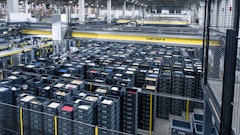
For too long, safety in the supply chain has been viewed through a rearview mirror. But in 2023, transportation and warehousing had the highest injury and illness rate involving days away from work, per 10,000 workers, among all industries.
The current norm is for companies to investigate incidents after they happen, issue corrective actions, and hope to prevent the next one. However, that reactive model cannot keep up in an industry defined by its speed and complexity. The future of safe operations lies in visibility, connectivity, and adaptability. Technology is finally catching up to make that shift possible.
Safety as a system, not a silo
Traditional safety programs often exist separately from a company’s core operations. They rely on manual reporting, spreadsheets, and inconsistent and difficult communication between field teams and in-office management. When data lives in silos such as this, small gaps turn into large systemic blind spots. For example, a late maintenance report or an outdated vehicle inspection can turn into an operational risk.
No-code workflow platforms, however, are changing this equation. These tools allow organizations to integrate safety, logistics, and compliance processes together in one system without months of development or complex integrations. Frontline workers can input field data from mobile devices, safety teams can automate alerts, and leaders can view trends in real time.
The result is not just better data but a culture of continuous prevention. Risks are identified earlier, communication flows faster, and employees can see how their actions affect safety outcomes.
From reaction to prediction
Visibility is only the first step. The value of connected operations lies in predictive prevention, using real-time data to spot patterns and act before accidents occur. By centralizing information on a system or application created by the teams themselves, companies can uncover the root causes of risk instead of reacting to isolated events.
For example, if a company's analytics reveal that their Midwest-based fleet experiences the most near-misses, managers can examine whether vehicle condition, route, driver training, or scheduling contributes to the trend. This level of insight enables targeted interventions such as retraining teams, adjusting workloads, or updating safety protocols before incidents escalate. And it enables the shift from “what happened?” to “what could happen, and how do we stop it?”
Designing for safety and scalability
The real strength of this technology lies in its accessibility. No-code tools put process design directly in the hands of the people closest to the work. Safety leaders, not programmers, can build and adapt workflows as conditions change. That agility is critical in industries where operations evolve faster than traditional IT cycles can manage.
When technology empowers teams to act quickly, safety becomes scalable:
· Process improvements made in one facility can be rolled out across dozens more within days.
· A new hazard reporting workflow can be shared instantly across a mobile workforce.
· A maintenance inspection form can be customized and distributed fleet-wide within hours to address emerging equipment risks.
As the supply chain continues to digitize, the question for leaders is not whether to adopt connected operational technology, but how quickly they can do it. Organizations that treat safety as a data-driven discipline, by integrating safety into daily operations and equipping teams with the proper tools, will thrive. Because the safest supply chains will belong to those that can see and act before the problem starts.




















